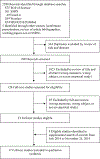Malpractice Liability and Health Care Quality: A Review
- PMID: 31990319
- PMCID: PMC7402204
- DOI: 10.1001/jama.2019.21411
Malpractice Liability and Health Care Quality: A Review
Abstract
Importance: The tort liability system is intended to serve 3 functions: compensate patients who sustain injury from negligence, provide corrective justice, and deter negligence. Deterrence, in theory, occurs because clinicians know that they may experience adverse consequences if they negligently injure patients.
Objective: To review empirical findings regarding the association between malpractice liability risk (ie, the extent to which clinicians face the threat of being sued and having to pay damages) and health care quality and safety.
Data sources and study selection: Systematic search of multiple databases for studies published between January 1, 1990, and November 25, 2019, examining the relationship between malpractice liability risk measures and health outcomes or structural and process indicators of health care quality.
Data extraction and synthesis: Information on the exposure and outcome measures, results, and acknowledged limitations was extracted by 2 reviewers. Meta-analytic pooling was not possible due to variations in study designs; therefore, studies were summarized descriptively and assessed qualitatively.
Main outcomes and measures: Associations between malpractice risk measures and health care quality and safety outcomes. Exposure measures included physicians' malpractice insurance premiums, state tort reforms, frequency of paid claims, average claim payment, physicians' claims history, total malpractice payments, jury awards, the presence of an immunity from malpractice liability, the Centers for Medicare & Medicaid Services' Medicare malpractice geographic practice cost index, and composite measures combining these measures. Outcome measures included patient mortality; hospital readmissions, avoidable admissions, and prolonged length of stay; receipt of cancer screening; Agency for Healthcare Research and Quality patient safety indicators and other measures of adverse events; measures of hospital and nursing home quality; and patient satisfaction.
Results: Thirty-seven studies were included; 28 examined hospital care only and 16 focused on obstetrical care. Among obstetrical care studies, 9 found no significant association between liability risk and outcomes (such as Apgar score and birth injuries) and 7 found limited evidence for an association. Among 20 studies of patient mortality in nonobstetrical care settings, 15 found no evidence of an association with liability risk and 5 found limited evidence. Among 7 studies that examined hospital readmissions and avoidable initial hospitalizations, none found evidence of an association between liability risk and outcomes. Among 12 studies of other measures (eg, patient safety indicators, process-of-care quality measures, patient satisfaction), 7 found no association between liability risk and these outcomes and 5 identified significant associations in some analyses.
Conclusions and relevance: In this systematic review, most studies found no association between measures of malpractice liability risk and health care quality and outcomes. Although gaps in the evidence remain, the available findings suggested that greater tort liability, at least in its current form, was not associated with improved quality of care.
Figures
Comment in
-
Malpractice Liability and Quality of Care: Clear Answer, Remaining Questions.JAMA. 2020 Jan 28;323(4):315-317. doi: 10.1001/jama.2019.22530. JAMA. 2020. PMID: 31990297 No abstract available.
-
Medical Litigation and Its Influence on the Quality of Medical Care.Ir Med J. 2020 Mar 13;113(3):32. Ir Med J. 2020. PMID: 32815674 No abstract available.
Similar articles
-
Association Between State Medical Malpractice Environment and Surgical Quality and Cost in the United States.Ann Surg. 2016 Jun;263(6):1126-32. doi: 10.1097/SLA.0000000000001538. Ann Surg. 2016. PMID: 27167562
-
Statutory caps: an involuntary contribution to the medical malpractice insurance crisis or a reasonable mechanism for obtaining affordable health care?J Contemp Health Law Policy. 1993 Spring;9:337-75. J Contemp Health Law Policy. 1993. PMID: 10126943
-
Resolving Malpractice Claims after Tort Reform: Experience in a Self-Insured Texas Public Academic Health System.Health Serv Res. 2016 Dec;51 Suppl 3(Suppl 3):2615-2633. doi: 10.1111/1475-6773.12609. Epub 2016 Nov 4. Health Serv Res. 2016. PMID: 27813058 Free PMC article.
-
Damages caps in medical malpractice cases.Milbank Q. 2007 Jun;85(2):259-86. doi: 10.1111/j.1468-0009.2007.00486.x. Milbank Q. 2007. PMID: 17517115 Free PMC article. Review.
-
Creating outcomes-based systems for quality and malpractice reform: methodology of accelerated compensation events (ACEs).Milbank Q. 1992;70(1):183-216. Milbank Q. 1992. PMID: 1588891 Review.
Cited by
-
Impact of System and Diagnostic Errors on Medical Litigation Outcomes: Machine Learning-Based Prediction Models.Healthcare (Basel). 2022 May 12;10(5):892. doi: 10.3390/healthcare10050892. Healthcare (Basel). 2022. PMID: 35628029 Free PMC article.
-
What are the health consequences associated with differences in medical malpractice liability laws? An instrumental variable analysis of surgery effects on health outcomes for proximal humeral facture across states with different liability rules.BMC Health Serv Res. 2022 May 3;22(1):590. doi: 10.1186/s12913-022-07839-0. BMC Health Serv Res. 2022. PMID: 35505315 Free PMC article.
-
The Wicked Problem of Physician Well-Being.Anesthesiol Clin. 2022 Jun;40(2):213-223. doi: 10.1016/j.anclin.2022.01.001. Epub 2022 May 4. Anesthesiol Clin. 2022. PMID: 35659395 Free PMC article. Review.
-
Lab testing overload: a comprehensive analysis of overutilization in hospital-based settings.Proc (Bayl Univ Med Cent). 2024 Feb 8;37(2):312-316. doi: 10.1080/08998280.2023.2288788. eCollection 2024. Proc (Bayl Univ Med Cent). 2024. PMID: 38343466 Free PMC article. Review.
-
The Frontline Nurse's Experience of Nursing Outlier Patients.Int J Environ Res Public Health. 2020 Jul 20;17(14):5232. doi: 10.3390/ijerph17145232. Int J Environ Res Public Health. 2020. PMID: 32698431 Free PMC article.
References
-
- Keeton WP, Dobbs DB, Keeton RE, Owen DC. Prosser and Keeton on the law of torts. 5th ed. ed. St. Paul, Minn: West Group; 1984.
-
- Studdert DM, Mello MM, Brennan TA. Medical malpractice. New England Journal of Medicine. 2004;350(3):283–292. - PubMed
-
- Grady MF. Better medicine causes more lawsuits, and new administrative courts will not solve the problem. Northwestern Univ Law Rev. 1992;86(4):1068–1093.
-
- Schwartz GT. Reality in the economic analysis of tort law: does tort law really deter? UCLA Law Rev. 1994;42(2):377–444.


